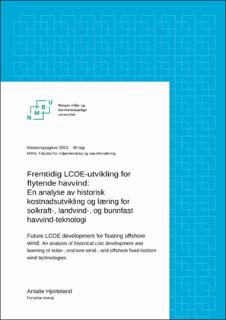| dc.contributor.advisor | Kristin Linnerud | |
| dc.contributor.author | Hjorteland, Amalie | |
| dc.date.accessioned | 2023-07-06T16:29:17Z | |
| dc.date.available | 2023-07-06T16:29:17Z | |
| dc.date.issued | 2023 | |
| dc.identifier | no.nmbu:wiseflow:6839539:54591934 | |
| dc.identifier.uri | https://hdl.handle.net/11250/3076827 | |
| dc.description.abstract | Verden går inn i en fase med stor satsing på elektrifisering og opprustning av fornybare
teknologier. Flytende havvind antas å være en av teknologiene som vil bidra med størst
kapasitet inn i både det europeiske og amerikanske kraftmarkedet. Denne masteroppgaven
bruker historiske læringskurver og tilhørende læringsparametere for solmoduler, landvind og
bunnfast havvind for å estimere mulige scenario av læringskurver for flytende havvind. Å
kartlegge hvordan utviklingen og læringsraten kan se ut for flytende havvind, og analysere
læringseffektene som ligger bak, gir det et bedre grunnlag for å nå havvindaktørenes
ambisjonsnivå for kostnadsreduksjon. Kostnadsreduksjon er nødvendig for å gjøre flytende
havvind konkurransedyktig med konvensjonelle kraftteknologier som gass og kull, men også
andre fornybare teknologier. Resultatet fra analysen er at LCOE estimeres til å bli mellom
0,026 $/kWh-0,071$/kWh for fremtidig kumulativ kapasitet på 50 GW, mellom 0,02 $/kWh0,06$/kWh for 100 GW kumulativ kapasitet, og mellom 0,016$/kWh-0,054$/kW for 200 GW
kumulativ kapasitet, dersom flytende havvind følger samme utvikling som teknologiene
læringskurvene baseres på. En slik utvikling gir en læringsrate på mellom 13,2-22,3%.
‘Economies of scale’, ‘learning-by-doing’ og ‘spillover’-effekten har vært de viktigste
læringseffektene for den historiske kostnadsutviklingen for solmoduler, landvind og bunnfast
havvind, og forventes å bidra til kostnadsreduksjon for flytende havvind også. Oppgaven
konkluderer med at estimatene for LCOE er realistiske, men at for å nå dem så må flere land
og fagområder samhandle for å oppnå kommersiell utbygging av flytende havvind, som vil
bidra til et mer klimavennlig energimarked. | |
| dc.description.abstract | The world enters a phase with more substantial investments towards the electrification of
the energy market and building of renewable energy. Floating offshore wind is expected to
be one of the technologies which will contribute a great share of power into the European
and American power market. This master thesis uses learning curves and learning parameter
for solar PV, onshore wind, and offshore fixed-bottom wind to estimate possible, future
scenarios for floating offshore wind. Mapping the possible development and learning for
floating offshore wind, and analyzing the learning effects, gives a better basis for reaching the
offshore companies’ goals for cost reduction. Cost reduction is necessary to make floating
offshore wind a competitor alongside conventional power technologies, such as gas and coal,
but also other renewable technologies. The result of the analysis is that LCOE is estimated to
become a value in between 0,026 $/kWh-0,071$/kWh for future cumulative capacity of 50
GW, between 0,02 $/kWh-0,06$/kWh for 100 GW cumulative capacity, and between
0,016$/kWh-0,054$/kW for 200 GW cumulative capacity, if floating offshore wind follows the
same cost development as the other technologies. Such development results in a learning
rate between 13,2-22,3%. Economies of scale, learning-by-doing, and the spillover-effect,
have been the most important learning effects in the historical cost development for solar
PV, onshore wind, and offshore fixed-bottom wind, and is expected to be contributors to the
Side 3 av 60
cost reduction of floating offshore wind as well. The conclusion of the thesis is that the
estimates of LCOE are realistic, however, countries and different fields of study need to work
together to obtain commercial development for floating offshore wind, and in turn,
contribute to a more climate friendly energy market. | |
| dc.language | nob | |
| dc.publisher | Norwegian University of Life Sciences | |
| dc.title | Fremtidig LCOE-utvikling for flytende havvind: En analyse av historisk kostnadsutvikling og læring for solkraft-, landvind-, og bunnfast havvind-teknologi | |
| dc.type | Master thesis | |
